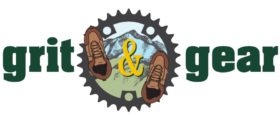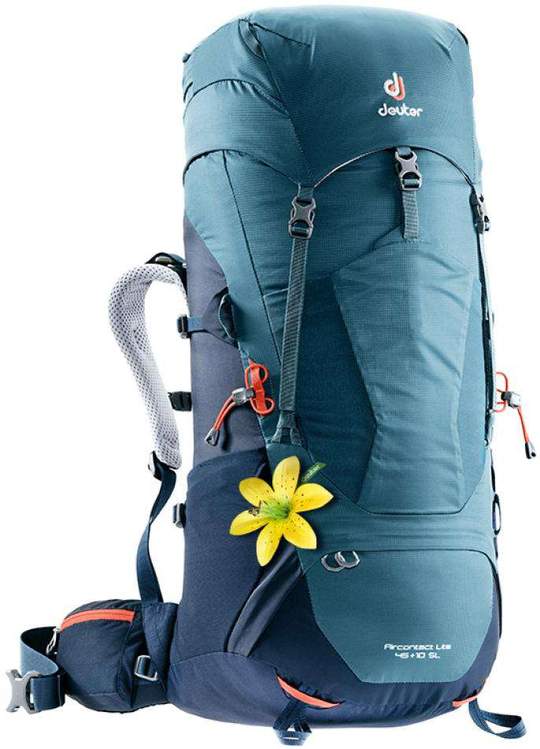As a guide and owner of AdventurHER Travel, there’s a lot riding on my gear (like my professionalism or reputation of my entire company); it has to work flawlessly. The Deuter Aircontact Lite SL 60+10 ($220) backpack handled twenty miles of rugged terrain on with a heavy load of gear beautifully on Minnesota’s Superior Hiking Trail during my Backpacking 101 Clinic. It remained comfortable and ergonomic the whole way — allowing me to focus on my clients’ first multi-night trip, not my gear.
What I Liked
Comfortable
First and foremost, I’ve never — ever — hiked with a pack this comfortable under a heavy load before. I truly used every last bit of the extended 70-liter capacity, carrying my gear, group gear, and, at times, three full bear canisters and clients’ gear. The extra padding around the lumbar spine meant that my lower back was protected from pressure points. The luxuriously padded hip belt kept my hips from bruising, and the similarly padded shoulder straps remained comfortable under 65+ pounds of gear, which is no small feat.

Mobility
Though parts of the Superior Hiking Trail are Midwest-style flat, the sections we covered in this clinic were some of the most rugged: ascents and descents, roots and rocks, and narrow trails on bluff edges required grace and balance. The weight distribution design kept the load secure where it should be, which is crucial with a bad SI joint, poor weight distribution can lay me out for days. It also meant that the pack never knocked me off balance while I was high-stepping up stone stairs or swinging over fallen logs.
Nothing inspires confidence on your first time in the backcountry like your guide wobbling under the weight of an ill-fitting, poorly-balanced pack before taking a digger on a root everyone else managed to gracefully step right over. The X-style aluminum internal frame is sturdy but flexible enough to never inhibit my movement, which is key when climbing over boulders and navigating roots and rocks.
Adjustability
The Variquick system ensures that the suspension system will work the way it’s intended, as a poor fit will negate any benefit. Take the time to make your pack fit correctly because with no fewer than 5 points for fine-tuning the fit of the pack, the Aircontact Lite is built to dial in the fit just right for your build. The long hip belt straps mean that you can have bodacious hips and still comfortably fit into the pack. The chest strap slides up and down with ease to accommodate bigger-chested backpackers. The SL women’s specific pack is already built with a shorter torso, but then it comes with the ability to adjust the torso length down to the inch, making this pack the traveling pants of the backpack world, magically fitting any woman who wears it. This also makes it a great option for a teen, as the length of the pack can grow with her.

What I didn’t Like
Access
With a top-loading pack this big, a side-access zipper would have turned the pack from Santa’s bottomless sack of presents into Mary Poppins’s bag: expansive yet well-organized storage[mm3] . With a sleeping bag in the bottom pocket, bottom access is impossible on the trail. Top access means dragging everything out of your pack and laying out a yard sale on the trail until you find what you need.
A side zipper would have stopped the unpacking and repacking. This means that accessing the medical kit to tend to clients involved sprawling bear cannisters, water filters, mess kits, and clothes onto the narrow trail in the dense forests of northern Minnesota. My apologies to anyone who had to hop-scotch around my belongings. At snack time or the beginnings of a rain storm, it’s important to have this bag packed very intentionally.
Hydration Pocket
Though I enjoyed having the hydration pocket and hose slot, the X frame arched into the pocket, meaning that fitting a full 3-liter bladder into the pack became an awkward game of Tetris I often lost. Stopping to refill and reposition the bladder meant emptying my pack and repacking it again.
Buckles & Straps
I am a big fan of side release buckles. I want to be able to easily remove and reattach the lid or straps to secure things to the outside of my pack. I missed having a sleeping pad compression strap and actually left my foam pad at home in favor of a more packable inflatable pad because I couldn’t attach my tent and my pad to the pack. I like using the lid as a rodent hang for items that don’t need to go in a bear canister, but even though the pack advertises a removable lid, I’m so clumsy with threaded buckles that it wasn’t even worth it to remove the lid from the pack. Maybe it’s just me. Maybe I just really, really need to get better at threading buckles properly. Maybe this isn’t a problem for you. Please teach me how to thread buckles properly!
Final Thoughts
This pack addresses one of the biggest issues I have with the outdoor gear industry: actually designing gear for women’s bodies. It’s highly adjustable and incredibly comfortable. It’s simple enough to be a great introductory pack for a beginner or a no-frills and streamlined pack for a more experienced trekker. It will easily handle 4 – 7 days on the trail with its roomy body and pockets, and the first few days of heavy weight are easily managed with the comfortable design of the pack. At 4 lbs 3 oz, it’s not for the ultralight backpacker, but it’s actually quite light considering all the padding and the size of it. I’m looking forward to taking this pack on my upcoming mountaineering trips (it even has ice pick loops). I know it can handle the extra gear.

